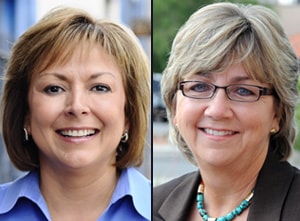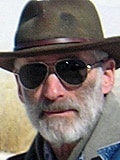
Susana Martinez (left, courtesy photo) and Diane Denish (photo by Heath Haussamen)
The end of the Richardson era is in sight, and Diane Denish, Democrat, and Susana Martinez, Republican, have their sights on the governorship. It never rains, but it pours; neither major party has nominated a female candidate for governor in New Mexico, but the state has two female candidates at present and will have one female winner in three months.
The state is lucky to have these two articulate and intelligent candidates. It is a shame that politics rather than policies have dictated the discussion so far. Already, I have heard some people talking about a cat-fight (I guess two men get into a dog-fight). Too bad, for the state cannot benefit from a race that reinforces gender stereotypes and undermines the winner even before she assumes office.
So one piece of advice is to have a race that lets the women show up the men and focus on the issues.
I sent both campaigns an e-mail requesting an interview and outlining my approach: three questions with one or two follow-ups as necessary on three different topics; no questions asked or answers wanted that were personal, partisan or “gotcha;” and everything recorded for accuracy, with a copy of the interview for each candidate.
I identified myself as a fortnightly columnist for the Las Cruces Sun-News but, assuming that I was unknown to both candidates, offered a brief account of my political background. I said that I am a left-leaning independent. I said that I think of myself as fair, committed to fairness, and open-minded even when I have an opinion, which I am willing to change or revise for good reason.

Michael L. Hays
The e-mails went out on June 7; both camps responded soon thereafter. The Denish campaign agreed the next day to the interview, and, with little ado, it occurred on June 25, when Diane was visiting Las Cruces. The Martinez campaign, reflecting both its growing pains and some personnel problems, took longer, needed more guidance (and wanted some help), but succeeded in arranging an interview after six weeks, on July 26.
From my point of view, the interviews were pleasant and productive, but not surprising.
The interview questions
I had three interview questions and provided printed copies of them one at a time as I asked them, and watched and listened. The questions:
When you set aside bad results like low test scores, low graduation rates, and high dropout rates, what are the two or three most important problems facing public education in New Mexico; what proposals are your solutions to them; and why do you believe that your proposals, if implemented, will work?
Do you believe that the state should intervene in energy markets; depending on your answer, what support, subsidies, tax credits, or tax deductions would you continue, increase, reduce, or discontinue; and why?
With respect to advance directives, what is the proper balance between the rights and interests of patients, and those of health-care professionals and institutions; does state law codify that balance; and, if not, what proposals would you make to establish it?
I asked this third question on a virtually invisible issue to ascertain the candidates’ reactions to a question they would not expect in an area in which they were probably inexpert. (I have long had a personal interest in this area, now better informed because of my wife’s recently completed honors thesis on this subject.)
And, given the greater costs to the state as a result of health care/insurance reform, end-of-life costs are going to increase. (A hint for the future: The question is not, as it will be initially and inflammatorily framed, about the value of a human life; it is about the limited resources which society can expend on an individual in a terminal condition.)
Education
Diane’s and Susana’s answers to the first question, on education, were unremarkable, consistent with their answers on their websites, but distinguishable from one another’s. For Diane, education is the third of six issues on her website; for Susana, it is the sixth of eight issues on her website.
Diane believes in more child care and early childhood education to ready children for school, improved instruction in the earlier grades, improved vocational education for the workforce (including high-school career academies), a redesigned senior year to prepare students for post-graduation education, and more opportunities for continuing education (like GEDs).
Susana believes in letter-grading schools to allocate resources to improve poorer ones, more technical-vocation education (with apprenticeships to businesses for those not going to college), merit pay and charter schools, and an end to social promotion.
On balance, Diane’s agenda is the more conventional; Susana’s is the more radical.
Diane is confident that early childhood education, which she claims has not yet had a chance to prove itself, will succeed. But similar efforts, like Headstart, have been around for decades, and their long-term educational benefits have not shown themselves to repay the resources invested. Susana’s interest in merit pay and charter schools may generate resistance in the education establishment; her opposition to social promotion may likely arouse parents and cause controversy about state-versus-local control of public education.
Both candidates share a belief, worrisome to me, that data on student performance can be effective in teacher evaluation. Both candidates share a disappointing – because it’s myopic – view of education as a sooner-or-later form of workforce training. Both mentioned reading, math and science; neither mentioned literature of any kind or history, economics, or government or civics – subjects important for life-long learning, personal growth and civic participation.
Intervention in energy markets
Diane’s and Susana’s answers to the second question, on intervention in energy markets, were markedly different. For Diane, energy is the sixth of six issues on her website; for Susana, it goes unmentioned on her website – a surprising omission because so much of her campaign money comes from contributors affiliated with the oil and gas industries.
Diane supports tax credits to energy companies – in fact, all companies – if and only if they create jobs and if energy companies generate revenues for New Mexico. She believes that smaller (and greener energy) businesses, like large ones before them, will play a larger role in increasing jobs and state revenues.
Susana opposes cap-and-trade, or, as she calls it, cap-and-tax, because she believes that it will impair energy development in the state and raise costs to residents. She supports tax credits to energy companies – indeed, to them and other extractive industries – for technology investments in greater efficiency and better environmental safeguards.
Although both candidates have different priorities – Diane’s emphasizing job creation, Susana’s stressing technology development – both are in surprising agreement in seeing a strong, though perhaps limited, role in government intervention in energy markets. Neither expressed a belief in free markets (if there is such a thing) or a concern that government intervention in energy markets does not have an unblemished record of encouraging economic efficiency, safety and health, or environmental well-being.
Advanced directives
Diane’s and Susana’s answers to the third question, on advanced directives, were a mixed bag of agreement and difference. Neither expected this question.
Diane’s reaction was remarkable and revealing. Diane hesitated, then admitted that she did not know about this issue, but added that the law had to be patient-friendly first. However, she said that she keeps an open mind and seeks information and advice on issues beyond those with which she is familiar.
Susana’s reaction was not surprising, but part of her answer was. I expected Susana, as a lawyer, to give an answer, but I did not expect her to doubt that this complex issue could be codified. However, she believes in the primacy of the patient’s wishes.
The only difference between Diane and Susana on this issue boils down to their handling of the unexpected. Diane admitted her ignorance; Susana attempted an answer despite her ignorance (the balance is codified in New Mexico law). My preference is for Diane’s admission to Susana’s attempt, because the one leaves the issue open and the other at least risks closing it prematurely.
Final thoughts
The race between these two fine candidates is a close one and, by all predictions, is likely to remain a close one. As I said, both candidates are articulate and intelligent; they are also informed and experienced.
On the three issues of my survey, I divide. On education, I find Susana’s specificity about increased assistance to ailing schools and an end to social promotion attractive. However, I fear a hidden agenda favoring merit pay, which I vigorously oppose, and charter schools, the benefits of many of which I question.
On energy, I find Diane’s linkage of interventions to jobs far more attractive than interventions to support something as risky as technology. On advanced directives, I think that both candidates have a long way to go on an issue which will likely become increasingly important over time. Diane’s admission of ignorance seemed more open, but Susana’s attempt at an answer in ignorance did not suggest inflexibility.
Right now, I am into watchful waiting to see which candidate handles herself best in addressing the issues and which campaign avoids attacking her opponent.
(Editor’s note: Even though neither major party has nominated a female candidate for governor in New Mexico, as was stated in this commentary, then-Secretary of State Soledad Chávez Chacón served as acting governor for two weeks in 1924.)
Michael L. Hays (Ph.D., English) is a retired consultant in defense, energy and environment; former high school and college teacher; and continuing civic activist. His bi-monthly Saturday column appears in the Las Cruces Sun-News; his bi-monthly blog, First Impressions & Second Thoughts, appears on the intervening Saturdays at firstimpressionssecondthoughts.blogspot.com.
